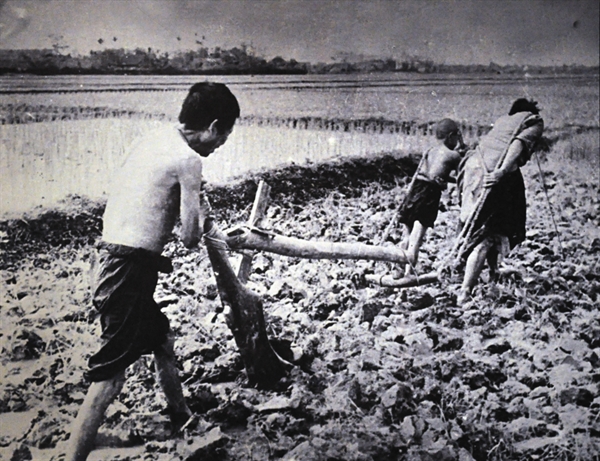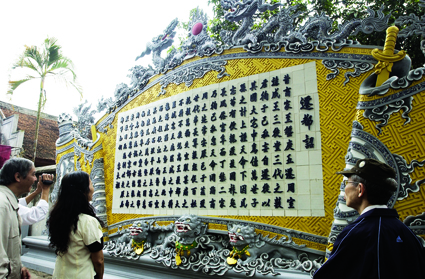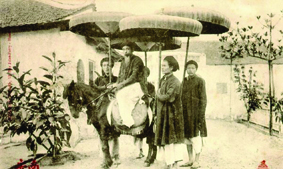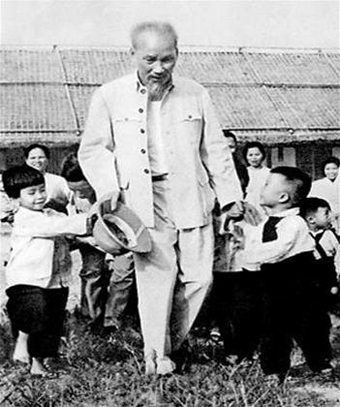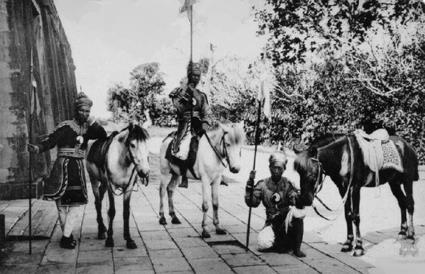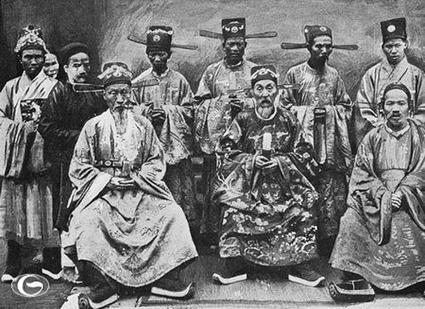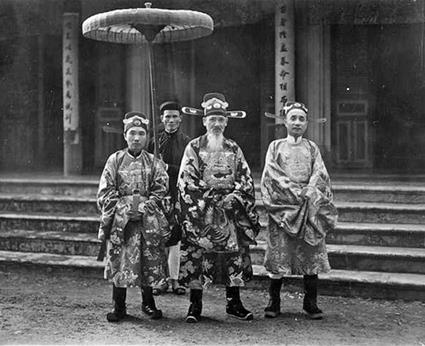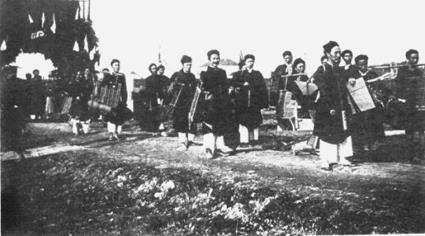Do Danh Huan, MSc.
History Institute
Vietnam Academy of Social Sciences
Under Vietnam’s Ly dynasty, the relations between Dai Viet (now Vietnam) and feudal China under the Song dynasty witnessed many ups and downs with good neighborly ties through high-level state visits and Vietnamese feudalists’ submission and payment of tributes to Chinese emperors and numerous land conflicts.
After big battles in 1059, 1075, 1076 and 1077 between Dai Viet and Song armies, peaceful negotiations were held in late 11th century for land border demarcation, focusing on Quang Nguyen region and Vat Duong and Vat Ac grottos.
In his studies, Prof. Hoang Xuan Han wrote: “Vat Duong grotto was the land paid as tribute to Song in 1064 by tribal chief Nung Tri Hoi and renamed as Quy Hoa by Song rulers while Vat Ac grotto was the land paid as tribute to Song in 1057 by Nung Tong Dan and renamed as Thuan An. These two grottos lie in the northern border area of Thach Lam district, northwest of Cao Bang province”.[1]
According to Dai Viet Su Ky Toan Thu (A Complete History of Dai Viet), in the third lunar month of the year of Binh Thin (1076), Song troops under the command of Kuo Chi were sent to invade Dai Viet. The king sent Ly Thuong Kiet to fight the foreign invaders, defeating Song troops at the Nhu Nguyet river and reclaiming Quang Nguyen region, now in Quang Uyen, Phuc Hoa and Thach An districts of Cao Bang province.”[2]
Right in its early days, the Ly dynasty sent the kings’ envoys to China for maintaining good friendship. “In the year of Canh Tuat (1010), the Ly king under the reign name of Thuan Thien sent Luong Nham Van as his envoy to Song to build up good neighborly ties.”[3]
In turn, Song, as a big country, recognized the newly throned kings of Dai Viet. It even sent a mission to attend the funeral ceremony of King Ly Thai To in 1028 and recognize King Ly Thai Tong as “Giao Chi Quan Vuong” (King of Giao Chi region)[4]. “In 1029, the Song dynasty sent Chang Ying as the king’s envoy to attend the funeral and confer the title of “Giao Chi Quan Vuong”[5].
In response to the Song emperor’s good will, Dai Viet sent a mission to Song in 1030 with Le Oc Thuyen and Nguyen Viet Than as the king’s envoys paying a courtesy call.[6]
The tribute payment to the Song dynasty and working trips between Dai Viet and Song continued in subsequent years to tighten the friendship between the two countries.
After a period of good relationship, the contradictions between the two countries were temporarily eased and Dai Viet advocated raising the question of reclaiming Vat Duong and Vat Ac grottos as well as Quang Nguyen region for discussion with the Song dynasty. In that spirit, in 1078, the Ly dynasty sent Dao Tong Nguyen to negotiate with the Song dynasty for land reclamation. “In Spring, the first lunar month of Mau Ngo year (1078), the Ly king under the reign name of Anh Vu Chien Thang sent Dao Tong Nguyen to present the Song rulers five tamed elephants and ask for the return of Quang Nguyen and To Mau regions as well as captured inhabitants of these localities.”[7]
Though Quang Nguyen region was a far-flung forest area with harsh weather conditions, which took the lives of a great number of occupying foreign troops, the Song rulers still persisted in not returning it to Dai Viet.
 |
| Front gate of Do temple in Bac Ninh province where the eight kings of Ly dynasty are worshipped__Photo: Internet |
In order to demand the Song dynasty to return Quang Nguyen region, Ly Thuong Kiet launched attacks on Ung Chau, Kham Chau and Liem Chau regions within the Song territory and captured a large number of local inhabitants and mandarins. Consequently, the Song dynasty agreed to return Quang Nguyen region to Dai Viet in exchange for the Song prisoners. The Song emperor then said: “I myself comfort all vassal states, near and far, but you have to return the Ung and Kham inhabitants you have taken them away. Upon the complete return of such people, I will immediately offer you Quang Nguyen region.”[8]
In return, the Ly dynasty’s negotiation mission headed by Dao Tong Nguyen replied: “We will return one thousand Song mandarins we have captured.” In such negotiations, the Song emperor agreed to return Quang Nguyen on the condition that Dai Viet must punish the instigators of attacks on the Song territory and capture of Song inhabitants. Such demand of the Song dynasty was rejected by Dai Viet.
As a result, the Dai Viet-Song negotiations on Quang Nguyen region came to a deadlock. In face of such circumstance, Ly Thuong Kiet implemented a plan to incite nearby inhabitants to attack into Quang Nguyen, putting pressure on the Song rulers. In response, Song troops were sent to the region for pacification in the border area. However, the longer the Song troops stayed Quang Nguyen, the heavier the losses they suffered because of sickness and attacks from Dai Viet. General Chao Hsueh of the Song dynasty admitted that it was unable to keep Quang Nguyen. Out of weariness, the Song rulers started letting things run their course and revealed their intention to return Quang Nguyen to Dai Viet. Availing himself of this opportunity, Ly Thuong Kiet freed a number of Song prisoners. In a report made in 1079, a Song envoy said: “Giao Chi returned only 221 but not 1,000 captured people as promised.” The then Song emperor, Song Shen Zong, ordered the envoy “to receive the prisoners then leave Thuan Chau (namely Quang Nguyen) and hand it to Giao Chi.”[9]
Though the Song emperor’s order only mentioned Thuan Chau, the Song dynasty actually returned all four regions occupied by its troops, including Quang Nguyen, Tu Lang, Mon, To Mau and Quang Lang.
The return of Quang Nguyen to Dai Viet under the Ly dynasty was recorded in historical books as follows: “In the year of Ky Mui under the reign name of Anh Vu Chieu Thang (1079), the Song dynasty returned Thuan Chau (namely Quang Nguyen, which had been renamed as Thuan Chau by Song rulers).”
After getting back Quang Nguyen, the Ly dynasty had to find ways to reclaim Van Duong and Vat Ac regions which were still under the control of the Song feudalists. Hence, the diplomatic struggle for the restoration of Song-occupied land went on.
The Ly-Song negotiations were held in the sixth lunar month of 1083 at Vinh Binh camp in the Song territory with the Dai Viet delegation headed by Dao Tong Nguyen, who had succeeded in previous negotiations to reclaim Quang Nguyen region, and the Song delegation headed by Cheng Zhuo and Deng Kuieh.
At this talk, the Song refused to return the occupied land while Dai Viet’s head delegate Dao Tong Nguyen insisted: “Vat Duong and Vat Ac are small parts of Quang Nguyen region, which are hardly separated or sold. I myself will make a report to the royal court for decision.”[10] The Song delegation showed discontent at the firm attitude and stand of Dao Tong Nguyen who later left the negotiations.
As the negotiations at Vinh Binh camp failed, the situation along the Ly-Song frontiers grew tense. The Ly dynasty rallied troops near Quy Hoa region (namely Vat Duong renamed by the Song rulers) to increase pressure on the Song dynasty. On the 25th of the twelfth month of 1083, the chief of Qangxi province reported to the Song royal court: “Quy Hoa reported that Giao Chi is rallying troops in an attempt to reclaim our province.”[11]
At the same time, the Thang Long royal court sent Le Van Thinh and Nguyen Boi to the next negotiations. “The Ly dynasty does not want to terminate the negotiations. In the sixth lunar month of the year of Giap Ty (1084), the Ly king ordered Le Van Thinh and Nguyen Boi to Vinh Binh for resuming border talks with the Song.”12
The talks proceeded with hot debates. Dai Viet’s head delegate Le Van Thinh argued: “Quy Hoa and Thuan An regions are actually Van Duong and Vat Ac of Dai Viet, which are stealthily offered to the Song rulers by Dai Viet’s tribal chiefs. Meanwhile, a Song delegate said the land seized by the Song emperor’s troops could be returned but the land under your management which was handed over to us by our followers could hardly be returned. Le Van Thinh immediately responded: “Land has its owner. As the managers offered the land to you, that land became a thing stolen from its owner. Even the stealthy offer of land by its owner cannot be tolerated and the robbery and storage of stolen property are prohibited by the law, much worse now they offered the stolen land, thus creating a shame for the Song king.”13
In face of sharp arguments and vivid evidence presented by the Dai Viet delegation, the Song dynasty finally agreed to return to Dai Viet the land handed over to it by local tribal chiefs. On the 22nd of the tenth lunar month of 1084, the Song emperor sent to the Ly king a decree stating: “ I have considered the Song head delegate’s report that: As An Nam (Dai Viet) had previously reported that the grottos in Vat Ac and Vat Duong regions were not clearly defined. I have sent mandarins to the negotiations. Now that Le Van Thinh was sent to the frontier and the negotiations concluded, I decreed to return the land to An Nam.”14
However, the Song rulers only returned six districts of Bao Lac, Luyen, Mieu, Dinh, Phong and Can as well as Tuc and Tang grottos while still retaining Vat Duong and Vat Ac regions.15
So, with high determination to reclaim the lost land by all means, the Ly dynasty conducted clever, flexible and resolute diplomatic struggle to reclaim Quang Nguyen region and Vat Duong and Vat Act grottos. At the end of Vinh Binh talks, we restored a number of areas adjacent to Vat Duong and Vat Ac grottos from the Song dynasty, which also agreed to demarcate the frontiers between the two countries.-
